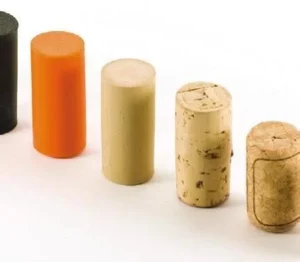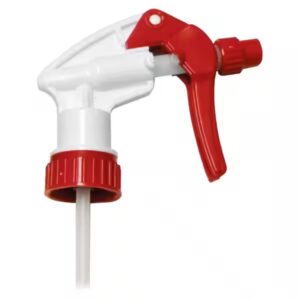Ask any winemaker about corks, and you’ll likely spark a debate. For centuries, natural cork has been the gold standard for sealing wine bottles, but synthetic alternatives have grown in popularity over the last few decades. The question isn’t just about tradition versus innovation—it’s about which one actually does a better job of helping wine age gracefully. After all, a cork’s true purpose is to protect the wine as it evolves, balancing oxygen exposure to develop complex flavors without letting the wine spoil. Let’s break down the differences, so you can decide which is right for your wine.

What is Natural Cork?
Natural cork comes from the bark of cork oak trees (Quercus suber), primarily grown in Portugal, Spain, and Italy. Harvesters carefully strip the bark by hand every 9–12 years, a process that doesn’t harm the tree—making it one of the most sustainable materials in winemaking. The bark is then boiled to soften it, cut into strips, and punched into cork-sized cylinders.
Key characteristics set natural cork apart:
- Porosity: Tiny pores allow a minuscule amount of oxygen to seep into the bottle over time—critical for aging.
- Elasticity: It expands to fit the bottle neck tightly, creating a seal that lasts for decades.
- Natural compounds: Tannins and lignin from the cork can subtly interact with the wine, enhancing complexity.
There are three main types:
- Whole natural corks: Made from a single piece of bark, ideal for premium wines.
- Colmated corks: Small holes in the bark are filled with cork dust, balancing quality and cost.
- Agglomerated corks: Made from ground cork pressed into shape, better for short-term storage.
What is Synthetic Cork?
Synthetic corks emerged in the 1990s as a solution to natural cork’s flaws. Most are made from polyethylene (a petroleum-based plastic), though plant-based versions (using materials like sugarcane) are gaining traction. They’re manufactured in factories, molded into uniform shapes, and designed to mimic natural cork’s sealing ability.
Key traits of synthetic corks include:
- Uniformity: Every cork is identical in size and density, reducing variability.
- Non-porous structure: They don’t let much (if any) oxygen through, which can be a blessing or a curse.
- Consistency: No natural imperfections, so they’re less likely to leak—at least in the short term.
Common types include solid synthetic corks (most popular), foam-based variants (softer but less durable), and blends (mixed with natural cork dust for better sealing).
Oxygen Transfer: The Make-or-Break Factor for Aging
Wine aging is a delicate dance with oxygen. Too much, and the wine oxidizes, turning flat and vinegar-like. Too little, and it fails to develop depth—remaining tight and underwhelming.
- Natural cork excels here. Its porous structure allows about 0.1–0.3 milliliters of oxygen per year to enter the bottle. This slow, steady flow softens harsh tannins in red wines, lets fruit flavors mature into more complex notes (like leather or tobacco), and stabilizes color. For wines meant to age 5+ years—think Cabernet Sauvignon or Bordeaux—this controlled oxygen transfer is essential.
- Synthetic cork is far less permeable. Most let in less than 0.05 milliliters of oxygen annually, and some are nearly airtight. This preserves the wine’s fresh, fruity characteristics, which is great for a crisp Sauvignon Blanc meant to be drunk within a year. But for long-term aging? The lack of oxygen leaves the wine underdeveloped, with tannins that never soften and flavors that stay stuck in their youth.
Aging Performance: Short-Term vs. Long-Term
Let’s cut to the chase: How do they perform over time?
- Natural cork is built for the long haul. A high-quality whole cork can maintain its seal for 20+ years, supporting the slow aging process that turns a good wine into a great one. It’s why premium wineries (think Barolo or Rioja Reserva) almost exclusively use natural cork—they need that gradual oxygen flow to develop the layered flavors their customers expect.
- Synthetic cork struggles with time. While it seals well for 1–3 years, the plastic can degrade over time, allowing sudden bursts of oxygen to enter. This leads to inconsistent aging: some bottles might oxidize, while others stay too closed off. Even the best synthetic corks aren’t reliable for wines intended to age 5+ years. They’re better suited for everyday wines—rosés, light Pinot Noirs, or unoaked Chardonnays—that are meant to be enjoyed young.
Pros and Cons for Wine Aging
Natural Cork
Pros:
- Enables the complex flavor development that defines well-aged wines.
- Sustainable and biodegradable—cork oak forests sequester millions of tons of carbon annually.
- Signals quality to consumers, who associate natural cork with premium wine.
Cons:
- Risk of TCA taint: About 1–3% of natural corks carry this chemical, which gives wine a musty, wet-cardboard smell (down from 10% a decade ago, thanks to better processing).
- Inconsistency: Natural variations mean some corks let in more oxygen than others, leading to uneven aging.
- Higher cost: A whole natural cork can cost 5–10 times more than a synthetic one.
Synthetic Cork
Pros:
- TCA-free: No risk of cork taint, which is a big win for reliability.
- Uniformity: Every bottle ages (or doesn’t age) the same way, which mass-market wineries appreciate.
- Affordability: Ideal for budget-friendly wines where cost matters more than long-term aging.
Cons:
- Limits aging potential: The lack of oxygen transfer stunts flavor development.
- Environmental concerns: Petroleum-based synthetics are non-biodegradable, contributing to plastic waste.
- Potential off-flavors: Some wines develop a subtle plastic-like taste after 1–2 years with synthetic corks.
Environmental and Sustainability Factors
Sustainability is a growing concern for wineries and consumers alike—and here, natural cork has a clear edge. Cork oak trees live for 200+ years, and each harvest supports biodiversity (these forests are home to endangered species like the Iberian lynx). The industry is also carbon-negative, as the trees absorb more CO2 than the production process emits.
Synthetic corks, on the other hand, have a heavier footprint. Petroleum-based versions rely on fossil fuels, and even plant-based synthetics require energy-intensive manufacturing. They’re also hard to recycle—most end up in landfills, where they can take centuries to break down.
Ideal Wine Types for Each Cork
- Choose natural cork if you’re bottling:
- Premium red wines (Cabernet Sauvignon, Nebbiolo) meant to age 5+ years.
- Sparkling wines (Champagne, Cava), which need slow oxygen exposure to develop toasty, brioche notes.
- Fortified wines (Port, Sherry), where controlled oxidation is key to their unique profiles.
- Choose synthetic cork if you’re bottling:
- Everyday reds, whites, or rosés meant to be drunk within 1–2 years.
- Budget-friendly wines where cost and consistency are priorities.
- Wines sold in high-volume retail (grocery stores, convenience shops) where taint risk must be zero.
Industry Trends and Winemaker Preferences
Premium wineries still swear by natural cork—80% of bottles over
20useit.Butsyntheticcorksdominatethebudgetmarket:about6010 opt for synthetics.
Innovations are bridging the gap. Some natural cork producers now use TCA-scanning technology to reduce taint risk to under 0.5%. Meanwhile, synthetic makers are developing more breathable formulas, though none yet match natural cork’s aging performance.
Consumers? Many still judge a wine’s quality by its cork. A 2023 survey found 72% of wine drinkers associate natural cork with “premium” or “artisanal” wines, while synthetic corks are seen as “everyday” or “budget.”
FAQ: Natural Cork vs. Synthetic Cork for Wine Aging
- Q: Can synthetic corks be used for wines aged 5+ years?
A: Technically, yes, but they’re not reliable. Most synthetic corks degrade over time, leading to inconsistent oxygen exposure. Stick to natural cork for long aging.
- Q: How common is TCA taint in natural corks today?
A: Thanks to better processing, it’s rare—about 1–3% of corks. Premium producers often use TCA-free certified corks to lower this risk further.
- Q: Do synthetic corks affect the taste of wine differently than natural corks?
A: Yes. Natural cork can add subtle earthy or woody notes over time, while synthetic corks are neutral (though some wines develop plastic-like hints with prolonged contact).
- Q: Are there eco-friendly alternatives to both?
A: Yes—screw caps with oxygen-controlled liners are a sustainable option, though they’re less traditional. Plant-based synthetics (made from sugarcane) are also more eco-friendly than petroleum versions.
- Q: How do storage conditions impact each cork type?
A: Natural corks need humidity (60–70%) to stay elastic; dry conditions can make them shrink and leak. Synthetic corks are less sensitive to humidity but can warp in extreme heat.
At the end of the day, the choice between natural and synthetic cork comes down to your wine’s purpose. If you’re making a wine meant to be cellared for years, natural cork is worth the investment. For everyday wines drunk young, synthetic corks offer reliability and cost savings. Neither is perfect, but understanding their strengths helps you pick the one that’ll let your wine shine—whether it’s opened next month or next decade.






